Turkish Food Culture: A Paradise for Fermented Food Lovers
Mar 03,2022
Turkish Food Culture: A Paradise for Fermented Food Lovers
Mar 03,2022
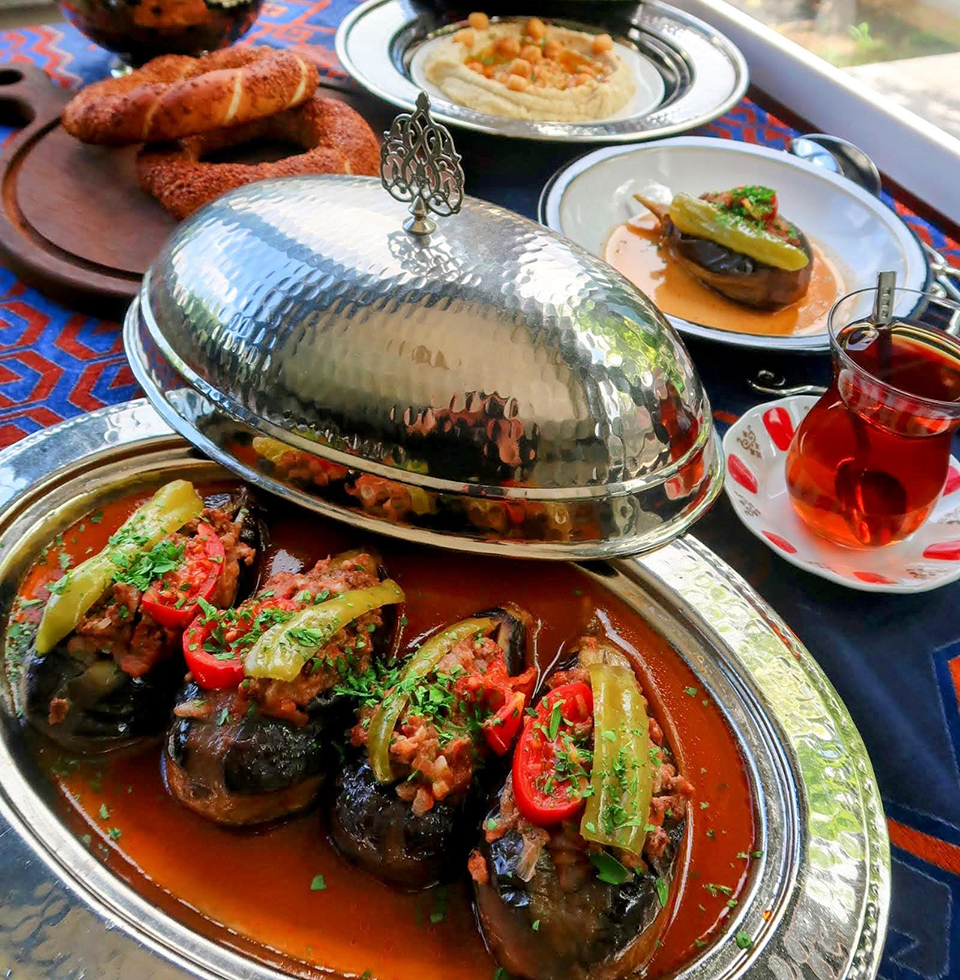

Turkish cuisine is so closely associated with shish kebab that quite a few people in Japan probably have little idea what else it has to offer. In fact, Turkey is one of the world’s great producers of fermented foods. Here, Turkish food expert Ohama Hiromi, who has lived in Turkey for twenty-six years, tells us about Turkish food culture and its magic.
Hiromi met her Turkish husband when she was studying in London. She has lived in Istanbul since 1995, after they married. When she first moved to Turkey, she had a real culture shock. She found herself part of a large extended family, with four related households living under the same roof.
“My husband and I lived on the first floor, with my in-laws above us. My husband’s younger brother and his wife lived on the next floor, and my husband’s older brother and his wife lived above them. Since it was an old-fashioned family, the womenfolk would spend the entire day from five o’clock in the morning until bedtime in the kitchen preparing food. It was the women’s job to make breakfast, lunch, and dinner, as well as prepare tea in the afternoon and after dinner. Turkish people love nothing more than a tea party.”
Hiromi mastered the art of Turkish home cooking over the course of this daily routine. Further, she studied professional cooking techniques and theory at the Turkish culinary school Mutfak Sanatları Akademisi (MSA). Then she launched Istanbul Kitchen, a cooking school for Japanese expatriates.
So what makes Turkish cuisine special? Its diversity, Hiromi says.
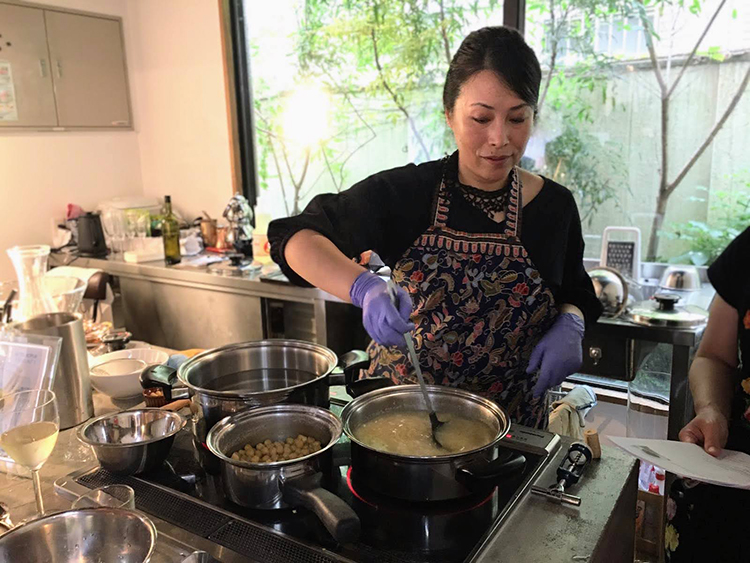
Ohama Hiromi giving a cooking class
“In Turkey, the food culture differs dramatically from region to region. Olive oil is extensively used in areas near the Aegean, while dishes made with butter and maize are common on the Black Sea coast. Meat dishes are common further east. This diversity is one of the hallmarks of Turkish cuisine. According to one scholar’s research, there are 156 eggplant dishes, 291 varieties of köfte or meatballs, and 50 varieties of the fermented food tarhana alone. And while much of the Turkish population is basically Muslim and doesn’t drink, there’s also a culture of drinking raki with meze or appetizers. Raki is the renowned Turkish distilled liquor that turns milky-white when water is added.
“On the subject of liquor, Turkey is also famous for its wine, which has been in the spotlight since Ankara University brought the Turkish grape variety Kalecik Karası back from the brink of extinction.”
The diversity that characterizes Turkish cuisines extends, of course, to fermented foods. One classic Turkish fermented food well known in Japan is yogurt. “Yogurt” is said to derive from yoğurmak, the old Turkish word for “churn” or “mix.” A staple of the Turkish dining table, it comes in various types and is served in many different ways.
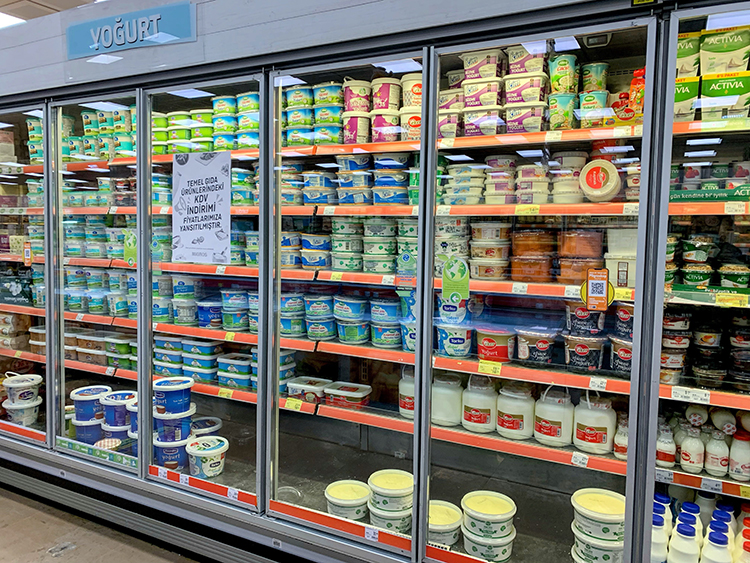
The yogurt section of the supermarket. A wide assortment of yogurts is on display.
“Lots of yogurt is used in the home, so almost every household has a stock of what is called bucketed yogurt — huge containers with over two kilograms of the stuff. In outlying regions, handcrafted yogurt is the norm. Vendors come to sell goat and sheep’s milk, which each family ferments themselves by adding starter culture. Goat’s milk yogurt is an acquired taste, but my husband loves it. He says it’s delicious.”
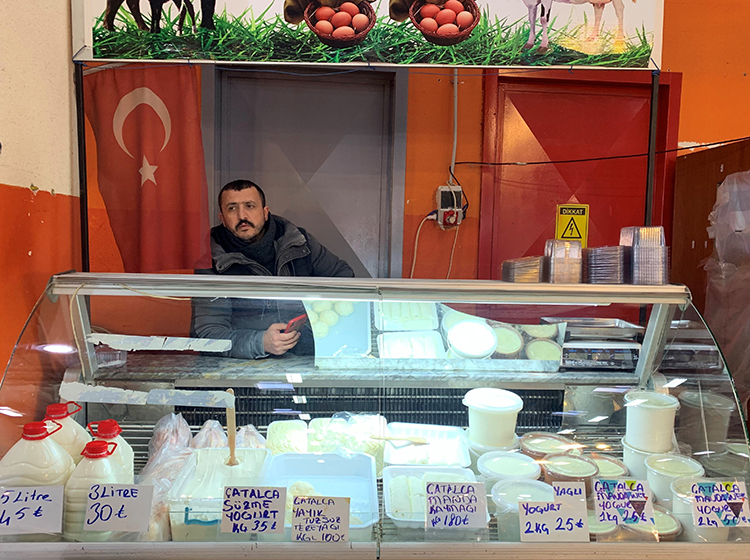
This artisanal dairy producer sells cow’s milk yogurt, strained yogurt, and water buffalo yogurt.
Besides cow’s milk yogurt, there’s also yogurt made from goat’s milk, sheep’s milk, and water buffalo milk. This yogurt is processed in various ways. It may be strained, salted, or dried. It’s commonly served on pilaf. It’s used to make a sauce for meze and mantı, a type of boiled dumpling. And it’s used as a marinade for meat and mixed into flour dough.
“Carrot tarator (yogurt salad) refers to a meze typically made with yogurt, garlic, and walnuts. Tarator is a dish that was once made in the Ottoman court. The word itself is derived from Greek. It can be used as is as a dip and also makes a great-tasting sandwich spread or sauce for meat or fish. This simple yogurt dish deserves to be enjoyed in homes across Japan.”
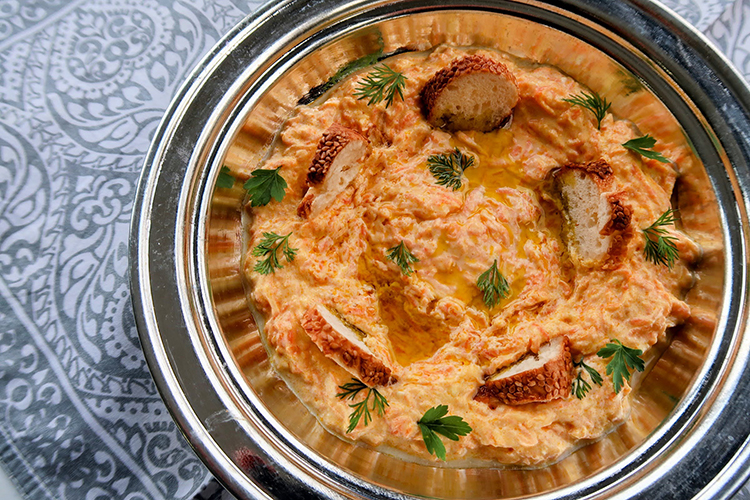
“Preferably, the yogurt should be a thick, strained variety like Greek yogurt. If you can’t find strained yogurt, I’d suggest straining ordinary yogurt with a coffee filter. The leftover liquid is whey, which is rich in protein, minerals, and other nutrients, so don’t throw it away. Drink it.”
A more processed form of yogurt is tarhana, a fascinating fermented food. It’s a preserved food made by fermenting a mixture of yogurt, wheat (sometimes in the form of a type of cracked wheat called “bulgur”), tomato, and onions, among other ingredients, then drying it out and grinding it into a powder.
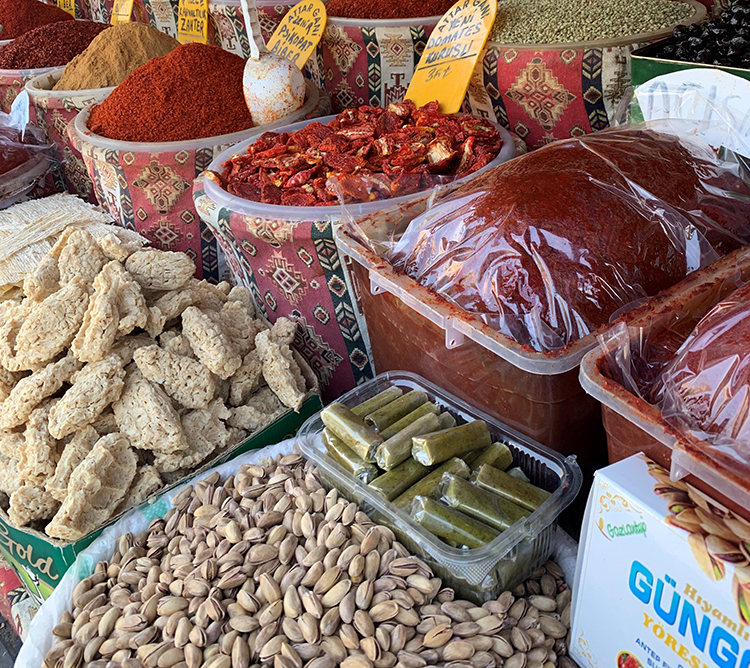
The white chunks at the front are tarhana, the main ingredients of which are wheat and yogurt. This is how tarhana is sold at shops in Gaziantep in southeast Turkey, which is also a major producer of spices and salça.
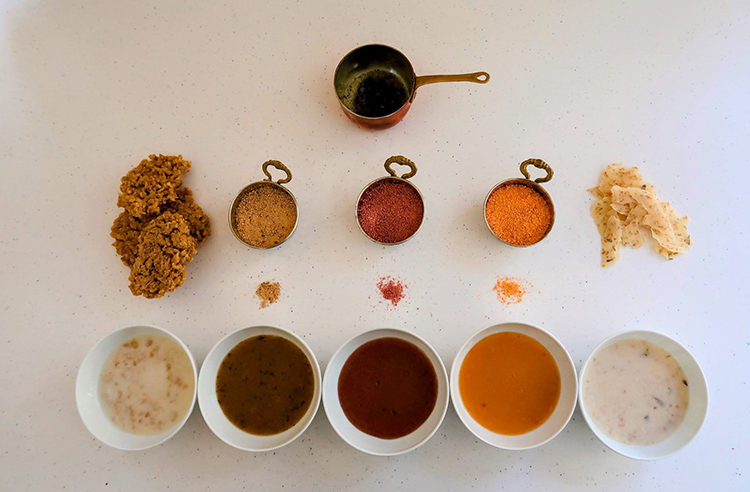
From left: Malatya tarhana, made from wheat and yogurt; Uşak tarhana, made by fermenting Sivas peppers, yogurt, wheat flour, onions, tomatoes, and mint for at least 21 days; kızılcık tarhana (cornelian cherry tarhana) from the Bolu region, which has a fruity, sour taste; the most common form of tarhana (the orange stuff); and (far right) tarhana chips from Kahramanmaraş.
“Tarhana is said to be the world’s oldest instant soup, having been produced since the sixteenth century. It was invented as a food for troops to carry with them in wartime, which I guess is why it keeps so well. It’s also eaten in the form of a soup called tarhana çorbası, which is made by sautéing a fermented tomato paste called salça in butter and adding tarhana dissolved in water.”
The salça used in tarhana çorbası is another classic Turkish fermented food.
“Salça is the equivalent of Japanese miso or soy sauce. In our home, all the womenfolk would get together to make it. It’s a paste made by placing cut tomatoes in a forty-liter bucket, salting them, then fermenting them in the sun. If you prepare a batch in the summer, when the best-tasting tomatoes are available, and stash it away, you can use it all year round. In some regions salça is made with red peppers. I suppose it’s like barley miso versus rice miso in Japan.”
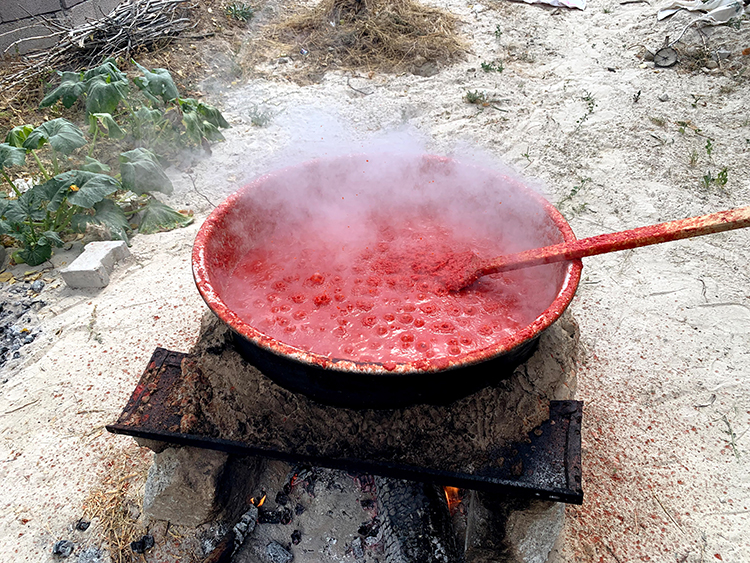
Tomato salça being made in the Cappadocia region in central Turkey
Salça is often used in stewed foods. One signature dish made with it is kuru fasulye or stewed white beans. In addition, it’s widely used in stewed meat dishes and features in soups. It’s also sautéed in butter to make a sauce. This basic seasoning truly is the Turkish miso.
Tomato salça and red pepper salça are sometimes combined in a way reminiscent of blended miso.
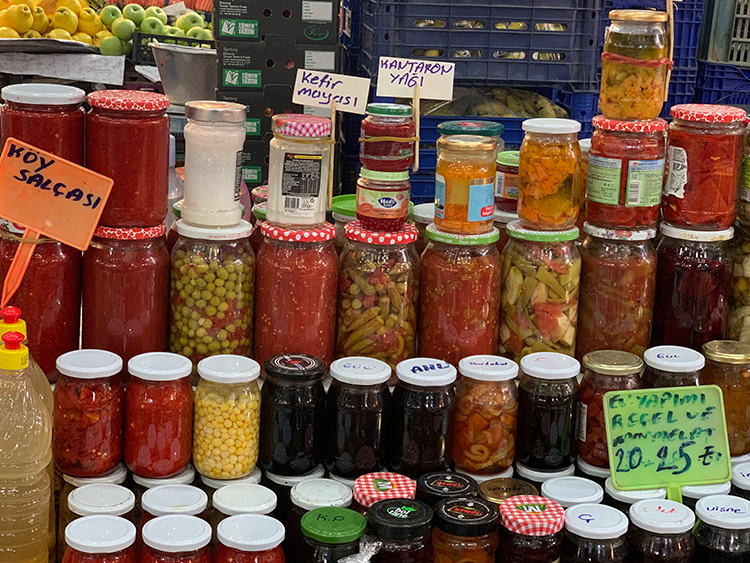
In Turkey, vegetables are commonly preserved in the form of fermented pickles.
“There are even specialized pickle dealers, and they pickle every vegetable under the sun: cucumbers, cabbage, okra, eggplant, green, unripe tomatoes, beetroot, onions, you name it. The brine used for pickling consists of water, salt, vinegar, and garlic, with dried chickpeas sometimes added as a starter.”
“Chickpeas also serve as a starter for tarhana, plus they’re used to activate the yeast in bread. Chickpeas, which have been eaten since Mesopotamian times, are a symbol of fertility for the Turks. They’re a vitally important food.”
Turkey also offers a wide assortment of fermented beverages.
“Şalgam is made by fermenting purple carrots and turnips in a salty brine, yielding a red liquid consumed as a juice. It’s often drunk with shish kebab: it neutralizes the greasiness of the meat.
“Boza, which is made by fermenting wheat, barley, or other grains, is a thick white beverage resembling the Japanese fermented rice beverage amazake. It’s a winter drink, and vendors go around selling it with cries of ‘Boza! Boza!’, much as vendors hawk roasted sweet potatoes in Japan. It’s supposed to be good for you. It’s seen as being a health drink.”
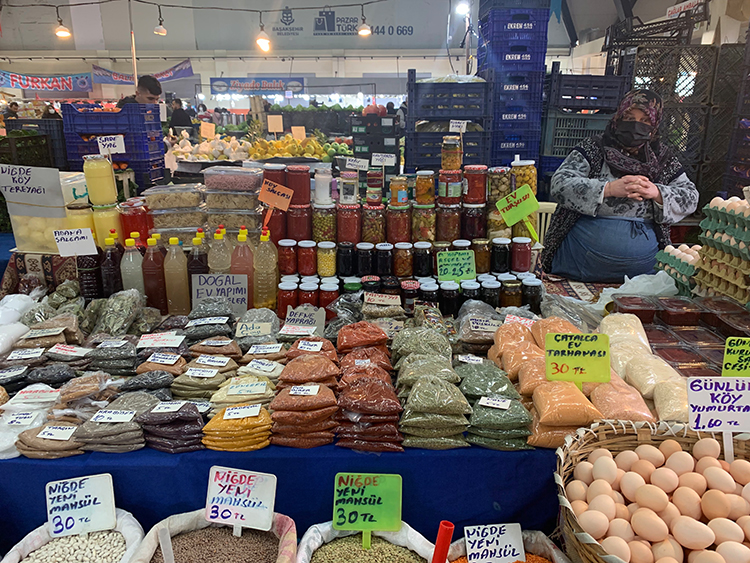
Woman selling handcrafted fermented foods: salça, fruit vinegar, butter, tarhana, and şalgam suyu (a pickle beverage). She made them all herself!
Hardaliye is a fermented beverage rich in local color. It’s rarely seen in Istanbul.
“When you ferment grapes they turn into wine, but this drink is made by adding mustard seeds to grape juice to prevent it from becoming wine. That way, you get fermentation but not alcohol fermentation, so what you end up with isn’t alcoholic. Hardaliye is a fermented beverage hardly known in Japan.”
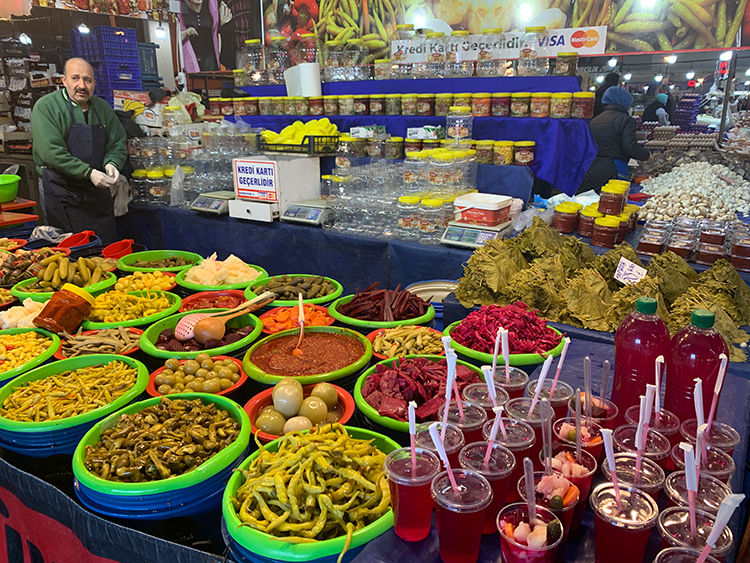
A vendor of turşu (pickles) at the bazaar. Here you can buy an assortment of as many different pickles as you like.
The reason Turkey offers such a variety of fermented foods, Hiromi speculates, is that people in Turkey are highly health conscious.
“Turks generally prefer handcrafted foods. They have an aversion to factory-produced foods. When you go to the supermarket, very little shelf space is given over to instant foods. Even when using something fermented like salça or tarhana, people typically either make it themselves, get some homemade from a friend, or buy it at the bazaar.”
Turkey’s cuisine and fermented foods are healthful and abounding in variety. Hiromi’s cooking classes will doubtless awaken many more people to their wonders.

Turkish food expert
Turkish food expert
Ohama Hiromi has lived in Turkey since 1995. She has run the cooking school Istanbul Kitchen since graduating from MSA’s professional chef’s program. Besides bringing Turkish cuisine to a Japanese audience, she also advises Turkish companies and restaurants about sushi and other Japanese foods.
Istanbul Kitchen (in Japanese only)